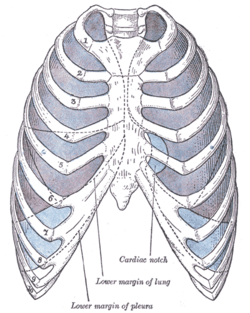Respiratory physiology

A highly diagrammatic illustration of the process of gas exchange in the mammalian lungs, emphasizing the differences between the gas compositions of the ambient air and the alveolar air (light blue) with which the pulmonary capillary blood equilibrates. The blood gas tensions in the pulmonary arterial (blue blood entering the lung on the left) and pulmonary venous blood (red blood leaving the lung on the right, which will circulate throughout the body) are indicated in the diagram. Note that the blood leaving the lungs has the same and values as the alveolar air (light blue). The ventilation of the lungs replaces only about 15% of the functional residual capacity (the 3 liter of air, in light blue, remaining in the lungs after a normal exhalation) per breath. The composition of that air therefore changes very little with each breath. The entire system is regulated by the arterial blood gas homeostat, which keeps the systemic arterial and constant (within very narrow bounds). All the gas tensions are in kPa. To convert to mm Hg, multiply by 7.5.
Respiratory physiology is the branch of human physiology focusing upon respiration.
Topics include:
Volumes
- lung volumes
- vital capacity
- functional residual capacity
- dead space
- spirometry
- body plethysmography
- peak flow meter
Mechanism

Front view of thorax.
Inhalation (breathing in) is usually an active movement. The contraction of the diaphragm muscles cause a pressure variation, which is equal to the pressures caused by elastic, resistive and inertial components of the respiratory system. In contrast, expiration (breathing out) is usually a passive process.
Where Pel equals the product of elastance E (inverse of compliance) and volume of the system V, Pre equals the product of flow resistance R and time derivate of volume V (which is equivalent to the flow), Pin equals the product of inertance I and second time derivate of V. R and I are sometimes referred to as Rohrer's constants.
- Anatomy: pleural cavity, thoracic diaphragm, Intercostales externi muscles, Intercostales interni muscles
- inhalation and exhalation
- lung, pulmonary alveolus
- With insufficient pulmonary surfactant, the pulmonary alveoli collapse, causing atelectasis (in infants, infant respiratory distress syndrome)
- the law of Laplace,
- compliance (physiology) - decreased with fibrosis, increased with emphysema[1]
- Poiseuille's law
- asthma and COPD
- hysteresivity
Circulation, ventilation, and perfusion
Pulmonary circulation
- pulmonary circulation
- positive pressure ventilation
- hypoxic vasoconstriction
- ventilation (physiology), perfusion, ventilation/perfusion ratio (V/Q), and ventilation/perfusion scan
- shunts: right-to-left (tetralogy of fallot), left-to-right (patent ductus arteriosus)
- respiratory rate and respirometer
Gas exchange/transport (primarily oxygen and carbon dioxide)

Oxygen-hemoglobin dissociation curve
- gas exchange
- Dalton's law
- hemoglobin
- oxygen-hemoglobin dissociation curve, Bohr effect, Haldane effect
- carbonic anhydrase
- oxyhemoglobin
- respiratory quotient
- arterial blood gas
Control and response

Pons
- control of respiration
- reticular formation
- pons (apneuistic and pneumotaxic)
- chemoreceptors (medulla, carotid body, aortic body)
- Hering-Breuer reflex
- involuntary control of respiration
- exercise
- hyperoxia
- hypoxemia (hypoxic hypoxia)
Disorders
- altitude sickness
- asthma
- carbon monoxide poisoning
- chronic obstructive pulmonary disease
- emphysema
- infant respiratory distress syndrome
- pulmonary edema
See also
- Breath sounds
- Pulmonology
- Respiratory system
- Wikipedia:MeSH G09#MeSH G09.772 --- respiratory physiology
- Respiratory monitoring
Additional images
References
External links
- Overview at Johns Hopkins University
- Clinical Sciences - Respiratory An iPhone app covering detailed respiratory physiology and anatomy
This article is issued from Wikipedia - version of the 9/23/2016. The text is available under the Creative Commons Attribution/Share Alike but additional terms may apply for the media files.


